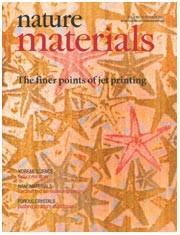
- Select a language for the TTS:
- UK English Female
- UK English Male
- US English Female
- US English Male
- Australian Female
- Australian Male
- Language selected: (auto detect) - EN
Play all audios:
You have full access to this article via your institution. Download PDF COVER STORY Inkjet printing has been investigated widely for use in applications such as electronics, biotechnology
and microelectromechanical systems, because of its simplicity, speed and the limitless range of patterns that can be achieved. With the need for ever-higher resolution of feature deposition
for component parts of devices, this technique has been pushed to its limits. Rogers and colleagues introduce a refined approach, modelled on lower-resolution technologies used for graphic
arts. By electrohydrodynamically inducing fluid flows through the microcapillary nozzles used for jet printing, they achieve submicrometre resolution with solutions of polymers,
nanoparticles, nanorods and single-walled carbon nanotubes. By printing metal interconnects, electrodes, probing pads and functional transistors, with critical dimensions as small as 1 μm,
the researchers demonstrate potential applications in printed electronics. [ARTICLE P782 ] SMALLER IS STRONGER Owing to their high strength, bulk metallic glasses have attracted significant
interest for applications in medical instruments, for example. However, metallic glasses are notoriously brittle under tensile strain, where the formation of shear bands leads to rapid
failure. Manling Sui and colleagues have now studied the tensile behaviour of 100-nm metallic glasses — only slightly larger than shear bands. They found that in the absence of any shear
band formation the tensile ductility is about ten times higher. Their fundamental impact aside, these findings suggest the application of these unique properties to thin films and
micrometre-sized devices. [LETTER P735 ] PHOTONIC QUASICRYSTALS Quasicrystals are intriguing structures that possess long-range order but no periodicity, leading to unique properties that
are different from regular crystals. For example, theory predicts that atomic rearrangements (known as phasons) within the crystals are possible as they do not affect the free energy.
However, such rearrangements are impossible to detect in an atomic quasicrystal. But by using a photonic analogue governed by the same fundamental physics, Moti Segev and colleagues are now
able to study the dynamics of phasons in detail. For example, they are able to confirm that phason strain relaxes much more slowly than phonon strain. [ARTICLE P776 ] ACCURATE STRUCTURES
Crystal structure of a metal–organic framework. Precise structural characterization of porous metal–organic frameworks is crucial for understanding their physical and chemical properties. So
far the crystal size of these compounds has limited the applicability of single-crystal diffraction analysis, even in a synchrotron. Thierry Loiseau and colleagues now report on a
diffraction set-up for the collection of Bragg intensities that pushes the crystal size limit down to the micrometre scale by using an X-ray beam focused to 1 micrometre. These data,
together with additional analysis from modelling and NMR, provide unprecedented and precise information about atomic arrangements. [LETTER P760 ] DIAGNOSTIC NANOPARTICLES For many illnesses,
for example prostate cancer, it is important to image the hydrogen peroxide concentration in the body. However, physiologic concentrations are very low and existing fluorescent contrast
agents have limited tissue penetration. Niren Murthy and colleagues have now developed a highly sensitive and specific contrast agent based on nanoparticles made from peroxalate polymer and
an embedded dye. When brought into contact with hydrogen peroxide, the peroxalate reacts and chemically excites the dye, leading to the detectable emission of light. The successful
demonstration of _in vivo_ deep-tissue imaging underlines the potential of this approach for diagnostic applications. [LETTER P765 ] BEAM ENGINEERING Irradiation of any structure with
electron or ion beams is often thought of as introducing disorder. However, recent experiments involving irradiation of various nanomaterials have demonstrated that the process can actually
be used as a tool to tailor and engineer structures and properties on the nanoscale. Indeed, in many cases irradiation can promote processes of self-organization or self-assembly. Arkady
Krasheninnikov and Florian Banhart review progress in this field, with a particular emphasis on carbon nanomaterials because of the unique ability of their networks to reconstruct under and
after irradiation. Both the physics underlying the irradiation and reconstruction processes as well as the technical applicability are discussed. [REVIEW ARTICLE P723 ] MIND THE GAP The
potential of graphene for electronic applications is hindered by the absence of a semiconducting gap in its band structure. Several routes based on geometrical restrictions have recently
been attempted to solve the problem, with varying success. Alessandra Lanzara and co-authors now show that in epitaxial graphene, interaction with the SiC substrate induces a small gap.
Although further confirmation is needed that the observed gap could indeed be used for electronic devices, the results are the first indication of the possibility to engineer the bandgap of
graphene through interaction with the substrate. [ARTICLE P770 ; NEWS & VIEWS P720 ] RIGHTS AND PERMISSIONS Reprints and permissions ABOUT THIS ARTICLE CITE THIS ARTICLE This issue.
_Nature Mater_ 6, v (2007). https://doi.org/10.1038/nmat2026 Download citation * Issue Date: October 2007 * DOI: https://doi.org/10.1038/nmat2026 SHARE THIS ARTICLE Anyone you share the
following link with will be able to read this content: Get shareable link Sorry, a shareable link is not currently available for this article. Copy to clipboard Provided by the Springer
Nature SharedIt content-sharing initiative








